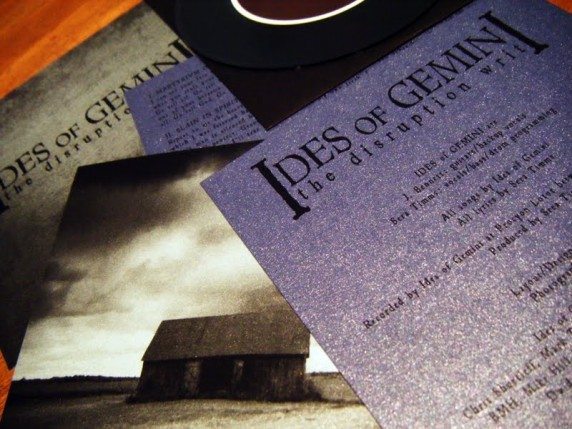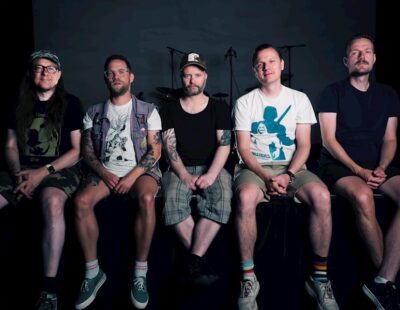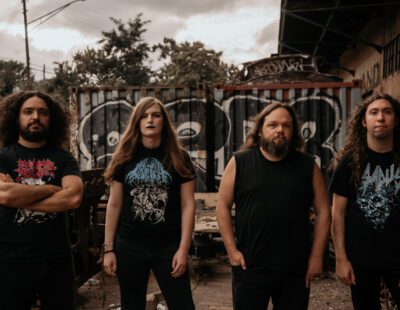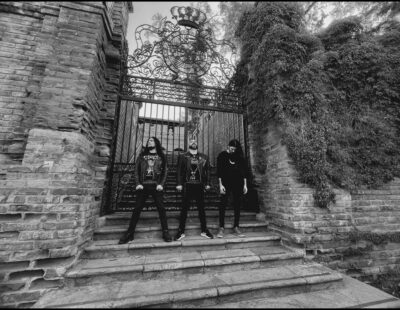For years and years, we’ve heard bands and musicians who’ve had their work slighted and slammed by the press defensively proclaim that so-and-so journalist should have his/her opinion taken with a grain of salt, or discounted entirely, because they’re not musicians themselves. That metal’s press corps should actually shut their pie-holes because they’re able to write coherent sentences better than they’re able to write music. Well, here’s an opportunity for the other half to test their writing acumen: Decibel’s franchise scribe, J. Bennett has reacquainted himself with his guitar and teamed up with his girlfriend, Black Math Horseman’s Sera Timms (vocals/bass/drum programming), to amble forth with Ides of Gemini, a collaboration combining black metal, 4AD moroseness and shoegaze rock. The duo (now a trio, with the addition of drummer Kelly Johnston) have a four-track EP available entitled The Disruption Writ which we’re sure bands that have occupied space on Bennett’s carving block since Decibel’s inaugural issue are racing to obtain and offer dismissive opinions about. If anything, at least those who do get their mitts on the EP, haters or otherwise, might learn a thing or two about worthwhile packaging. We caught up with Bennett for a quick chat earlier this week while he was mourning the loss of Ludicra and (probably) writing the next issue’s cover story.
Of course, you’re mostly known for your writing about music, not necessarily writing or playing music. In fact, until Ides of Gemini came along, I and most people, didn’t even know you played an instrument. How long have you been playing guitar and what sort of musical/band background do you have, if any?
I first started playing guitar when I was 16 years old, but I barely touched the thing between the ages of 20 and 33 – with the exception of a brief six-month period in the late ’90s when I started a short-lived project called the Everglades Enlightenment Program with the almighty Ironlung, frontman for the band Scissorfight. He played drums in EEP. We had a couple of what could loosely be termed “rehearsals” in Scissorfight’s former practice space in Waltham, MA – one of which resulted in a bitchy, but admittedly deserved, note left by an unnamed member of Slapshot (Dude’s other band shared the space with Scissorfight, and I had used his amp without asking). But my fondest recollection of EEP was when we practiced just prior to a Scissorfight rehearsal. When the members of Scissorfight arrived and asked us what kind of music we were playing, I told them it was black metal. To which the bass player responded, “You mean like Living Colour?” Later, my friend Don “Dondo” Jenks got involved and we recorded a few rudimentary songs, but EEP never really got off the ground. Lately, however, I’ve been thinking about resurrecting it for a seven-inch.
How long have you and Sera been doing IoG? Whose idea was it initially and what were you hoping to accomplish when you decided to put this project together?
I wrote the music for the first few songs in December of 2009, but Ides of Gemini didn’t really start in earnest until Black Math Horseman’s European tour was cancelled due to that unpronounceable Icelandic volcano that halted transatlantic air traffic for a few weeks in April of 2010. BMH and I were on the plane, ready to roll—I was tagging along as roadie/merch wizard—when they yanked everyone off and herded us into a hotel. After three fun-filled days of watching shitty TV news at the LAX Marriott in scenic Inglewood, we all went home and Black Math was forced to cancel the tour. Since Sera and I had already cleared our schedules for three weeks, we decided to start recording.
The initial idea was definitely mine, though. Sera was initially skeptical, if only because she didn’t really know I played guitar, either. And to be honest, I didn’t. I pretty much had to relearn the instrument to be able to do this. As anyone who has seen us play will attest, I’m definitely still learning. But as far as what we were trying to accomplish, my main goal was and still is to write songs specifically designed for Sera’s voice. We definitely have a specific atmosphere that we’re trying to achieve as well, and I like to think that atmosphere comes across on the EP.
It’s no secret that you guys are a couple. Most couples can’t even make dinner plans without it devolving into an argument. How do you manage working on a band together and not ripping each other’s heads off or letting it carry over into non-band time?
Oh, that’s easy: Sera is the boss. I know my place and I stay in it. Happily, I might add. Ides of Gemini is not about me, and that’s how I like it. As far as not carrying the band into non-band time, I’m not sure we really compartmentalize our time like that. Maybe that would be an issue if Ides of Gemini ever exited the fun phase. But if that happens, I suspect we wouldn’t do it anymore.
The liner notes of The Disruption Writ indicate you took the photos; photos which look pretty desolate, isolated and not very Los Angeles. Where are they from and what are they of?
Well, my Canadian friend, you might be pleased to learn that the cover photo was in fact taken in Quebec, just a few miles into Canada on the way from Boston to Montreal in September of 2003. I’m not sure what the building was or is, but I suspect it was an abandoned barn or farm house. At least that’s how I like to think of it. As far as the insert photo, it depends which version of the EP one has. The “Sunken Treasure” edition included a photo of the forest in the Santa Cruz Mountains, where Sera is from. The “True Blue” edition includes a photo of an unidentified body of water in South America, and was actually taken by Sera’s late grandfather, J. Stuart Rowley, though mis-credited in that edition. The first edition included 33 copies with the forest photo, 33 with the water photo (properly credited) and 34 with a photo of a rickety, abandoned rollercoaster that I took in Louisville, Kentucky.
In reading the lyrics, it would appear that there’s some sort of philosophical angle/theme to what’s going on, but everything is still vague enough to obscure clarity. What’s the overall theme to The Disruption Writ and how does the title, artwork/design and photography apply to that theme?
“Disruption” is an old-fashioned term for dismemberment, and all the songs on The Disruption Writ are about dismemberment, either literal or metaphorical. Mostly metaphorical. So, basically everything from being cut off from society (geographically or psychically) and/or the physical world (by death or trance states) or literally losing a fucking limb. The lyrics themselves are also allegorical and highly personalized. In one way or another, they were all derived from Sera’s own experiences. All the photos depict isolated subjects or locales, which represent both geographic and psychic dismemberment.
How much can you see yourselves dedicating to IoG? Is this going to be a project in the strict sense of the word, or can you see more time and energy being put towards the band? Are there any specific goals you’ve set or are you taking things as they come?
We are going full steam with Ides of Gemini. We officially made the transition from project to band when we welcomed drummer Kelly Johnston in May. She’s become a crucial ingredient because she’s an airtight drummer AND she can sing Sera’s harmonies, which is no easy feat. Plus, she totally rules as a person, which is obviously key. We are very lucky to have to have found her. Beyond that, Black Math Horseman is not really a touring band at present, so Sera has more time to dedicate to Ides now than we initially envisioned. And we definitely have specific goals as far as a full-length and touring. In fact, we hope to make some announcements to that effect soon.
For info about upcoming Ides of Gemini releases, shows and whatnot, check out: http://idesofgemini.blogspot.com/
And for the many bands that Shane Mehling has handed album review scores in the neighborhood of 0 and 1, watch this space for a future feature on Great Falls.







